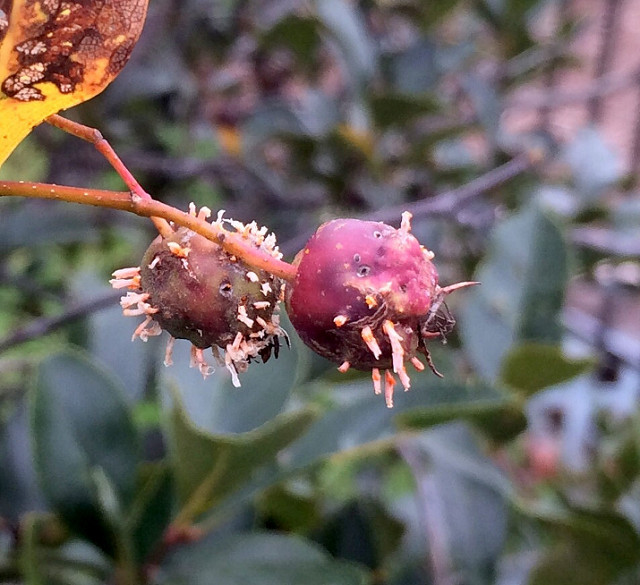This is the fourth part of a series on spring tree diseases. This article examines cedar-hawthorn rust, and cedar-quince rust.
Introduction
In spring, as the growing season commences, trees become vulnerable to infection from a bevy of diseases. While some of these diseases are relatively benign, many of them can cripple their hosts. The following describes some of the most common diseases to afflict plants in spring, and how they impact their hosts.
Cedar-Hawthorn Rust (Gynosporangium globosum)
Cedar-hawthorn rust is a fungal disease that commonly infects junipers and hawthorns. It is one of the most frequently observed plant diseases in spring and summer. The disease is caused by the pathogen Gynosporangium globosum. Cedar-hawthorn rust requires two hosts to complete its life cycle: a juniper, and a hawthorn. Several other plant species may also be infected.
Hosts
Cedar-hawthorn rust infects most varieties of eastern red cedar, as well as many other junipers. It may also infect numerous alternative hosts, including apples, crabapples, pears, quince, serviceberry, and hawthorns. Hawthorns are especially prone to infection.
Symptoms on Juniper
The cedar-hawthorn rust fungus produces reddish-brown galls on twigs, and small branches. Galls reach 1/8 to ½ of an inch in diameter. Immature galls are reddish-brown, while mature galls are grayish-brown. Once mature, circular depressions will appear on the galls. In spring, small brown structures begin to protrude from each of the depressions. These structures develop into an orange mass of telial horns, which contain infectious spores. Once the spores have been expelled from the galls, the galls become desiccated, and harden. Hardened galls may linger on junipers for several years.
Symptoms on Hawthorn and Other Alternative Hosts
Cedar-hawthorn rust causes discoloration on the leaves, fruit, petioles, and twigs of infected hosts. Discoloration is characterized by the appearance of tiny yellow spots, or lesions, on sections of the infected plant. As the growing season progresses, the lesions enlarge. They gradually turn orange, with small black dots forming in the center. By mid-summer, the telial horns will become visible on the underside of the mature leaf lesions, or within the lesions on the fruit, petioles, or twigs. On severely infected hosts, the foliage may turn bright yellow, and drop prematurely. Infected fruit will often rot, before being shed.
Treatment
- Cedar-hawthorn rust seldom kills trees, but it can disfigure plants when twigs are infected. As such, prune out diseased branches. This will limit the spread of the fungus, and help to prevent other sections of the plant, and nearby plants from becoming infected.
- Fungicide applications can be performed during sporulation. Thorough coverage of the plant is required to effectively combat the disease. Hawthorns and fruit trees should be sprayed prior to their bloom period in spring. Fungicides should be administered to junipers three times, at two-week intervals, beginning in mid-July.
- Avoid planting susceptible hawthorns within a two mile radius of junipers.
- Cull severely infected hawthorns, and replace them with genetically resistant varieties.
Cedar-Quince Rust (Gynosporangium clavipes)
Cedar-quince rust is a fungal disease that infects most varieties of eastern red cedar, as well as many other junipers, and alternative hosts. The disease is caused by the pathogen Gynosporangium clavipes. Cedar-quince rust requires two hosts to complete its disease cycle: an evergreen plant, and a deciduous plant. Infected plants generally experience significant branch dieback. Successive years of infection will reduce plant vigor. Some plants may eventually succumb to infection.
Hosts
Cedar-quince rust infects a broad range of plants in the rose family. Quince and flowering quince are two of the most ideal hosts for the pathogen. Apple, crabapple, hawthorn, pear, chokeberry, photinia, and serviceberry are also frequently infected. Eastern red cedar, common juniper, prostrate juniper, Rocky Mountain juniper, and savin juniper are common evergreen hosts.
Symptoms on Evergreens
Perennial, elongated branch swellings form on the tips of infected twigs and branches. As the disease progresses, the swellings may crack, and form cankers. Damp spring conditions cause orange, gelatinous blisters to erupt through the swellings. Small twigs and branches are often girdled, and killed. Severely infected evergreens may develop cankers on the main trunk. The girdling caused by the canker often culminates in plant mortality.
Symptoms on Deciduous Trees
On deciduous trees, the most conspicuous symptom of infection is the pink aecia that forms on the branches and fruit. Infected trees will often become laden with aecia. Perennial cankers develop on infected branches, and expand with each growing season. Most infected branches are girdled, and die back. Infected trees are often weakened, which reduces plant vigor. Cankers that extend into the main trunk may girdle, and kill the affected tree.
Treatment
- When planting, select trees that exhibit an increased resistance to cedar-quince rust. Avoid planting junipers close to susceptible trees.
- Promptly remove and dispose of any infected twigs, leaves, and fruit. Avoid composting the diseased trimmings.
- Cull plants that have formed cankers on the main trunk. Diseased plants with cankers on the main trunk are hazardous, and may collapse easily, especially when subjected to additional stressors. Removing the affected plant will also limit or prevent the spread of the fungus to nearby trees and shrubs.
- Fungicidal applications may be performed on the twigs and branches of infected junipers. Initial applications should take place as soon as the orange, gelatinous blisters become apparent on the infected branches. Continue treating infected trees at two to three week intervals until the blisters become inactive.


